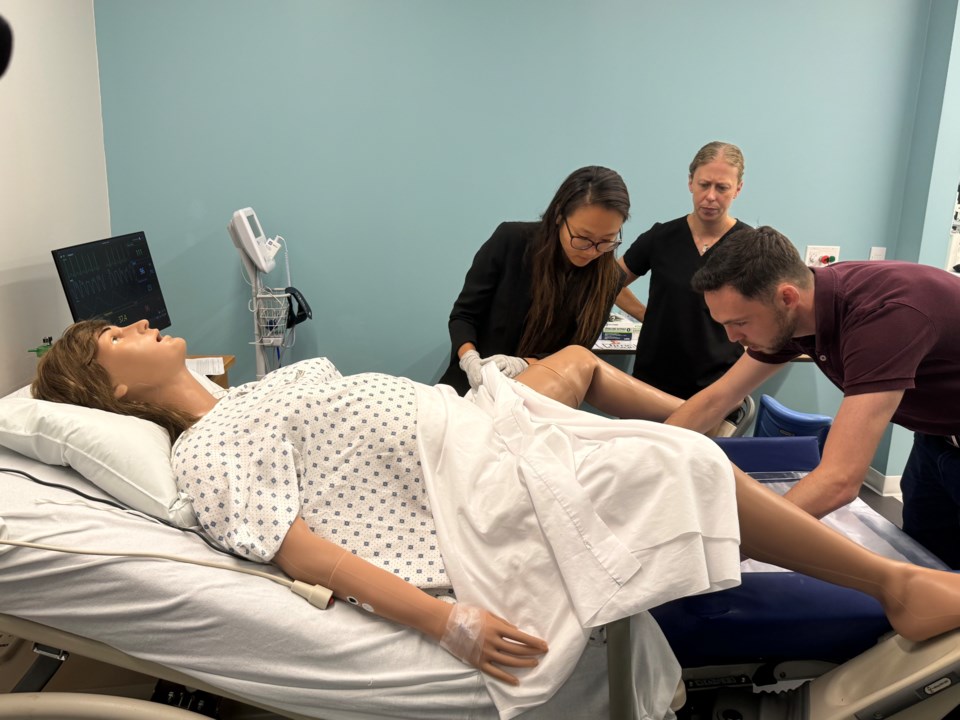Aspiring physicians had the opportunity to get hands-on experience with some high-tech "patients" during a training simulation at Georgian College's Barrie campus on Wednesday.
Residents from Royal Victoria Regional Health Centre’s family medicine teaching unit spent the morning running through several realistic obstetrics training scenarios using the college’s high-fidelity "manikins," which can replicate obstetrical emergencies.
This training will provide the physician residents with practical experience in a safe and immersive environment that will improve their clinical expertise.
Dr. Sarah Lankshear, the college's associate dean for nursing degree programs, explained the doctors took part in several different simulations including a labour, shoulder labour, as well as a postpartum hemorrhage.
“Our high-fidelity simulation labs allow students to be exposed to those highly stressful critical care patient scenarios in a very safe environment," she said. "We can run the scenario over and over again and it gives the students an opportunity to develop their competence and their confidence, so when they are exposed to these in a real-life setting they’ve already had a sense of what to do."
The technology has come a long way over the years, acknowledged Lankshear, who noted training for physicians today compared to even a decade ago is “significantly different.”
“Our high-fidelity simulation manikins are equipped with artificial intelligence. They come with certain scenarios we can actually run," said Lankshear. "She will speak, she will blink her eyes … During labour, she will not be happy (and) she will tell you she’s not happy. She will replicate a full-on labour.
“It’s amazing how quickly our students, even though it is a manikin, fall right into the scenario.”
This allows the training to be as close to a “real-life” scenario as possible, while keeping everybody safe, she said.
This type of program between the college and the hospital shows the benefits of the “practice-education partnerships,” added Lankshear.
“They are literally our neighbours and they are our biggest academic partner in terms of students (as well as) opportunities for collaborations and research, but what we do together is meet the health-care needs of our global community,” she said. “Georgian College (trains) our future health-care professionals and then that meets the health-care resource planning needs of all of our health-care partners, including RVH.”
Dr. Chris Martin, director of medical education and chief of critical care at RVH, called the collaboration between the two organizations a “natural partnership.”
“Our family medicine teaching unit … usually does most of their training within our own simulation lab, however Georgian has this wonderful facility with these simulators and equipment that we don’t have," he said. "We can use each other’s technology resources and education to train these residents in the best way possible."
In Wednesday’s scenario, participants were using the college’s obstetrics manikins to simulate both normal and high-risk deliveries, which the residents will need as part of their training in order to be a family physician in the community.
“We really want to try to train together, because their nurses and our physicians will have to work together at RVH when we are done training, so it makes sense to train together,” Martin said.
Today’s generation of medical student, he acknowledged, is very comfortable with technology and simulation, and it will only help to improve their training.
“Gone are the days where your first time seeing something was on a real patient. It’s now having to be taught with simulation, which is appropriate," said Martin. "You want to practise on these high-fidelity simulators before you actually have that scenario with a real patient.
“The technology is allowing the students to not only see these cases, but see them in such a high-fidelity that it’s really life-like," he added. "You get this stress inoculation and they feel like it’s real. They learn from any mistakes they make. Now’s the time to make them … and when they’re ready to treat patients it’s not their first time.”
Dr. Rainbow Megus is a first-year resident in the program and was one of the first to try the simulation today.
The Owen Sound native has delivered babies before, and says doing so in this type of training scenario will go a long way in helping new doctors get better prepared.
“This is very close to the feelings, the different motions of delivering a baby," Megus said. "Having this technology at this campus is really vital to helping other students and residents learn."
Megus also said it doesn’t feel too abnormal running through the scenarios.
“As soon as it starts, you’re kind of zoned in to exactly what is going on and you run through the motions as if you were doing this in real life. It was pretty easy for me to completely envelop myself and act as if this was a real-life scenario.”


.png;w=120;h=80;mode=crop)
